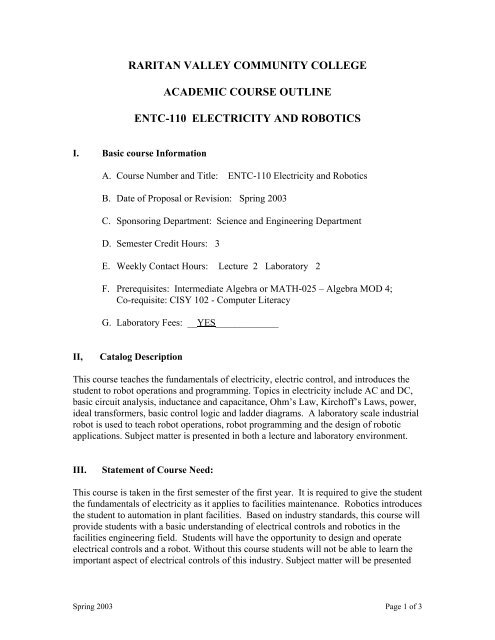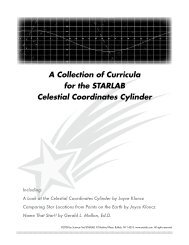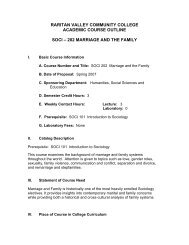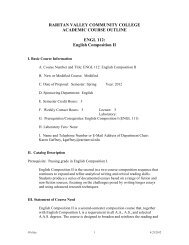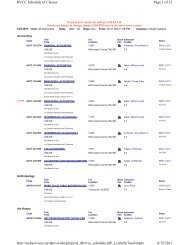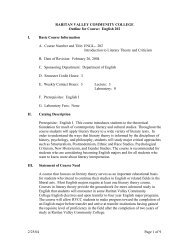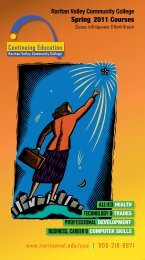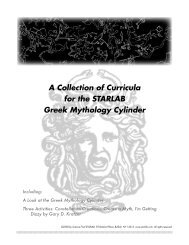ENTC110 Electricity and Robotics - Raritan Valley Community College
ENTC110 Electricity and Robotics - Raritan Valley Community College
ENTC110 Electricity and Robotics - Raritan Valley Community College
Create successful ePaper yourself
Turn your PDF publications into a flip-book with our unique Google optimized e-Paper software.
RARITAN VALLEY COMMUNITY COLLEGEACADEMIC COURSE OUTLINEENTC-110 ELECTRICITY AND ROBOTICSI. Basic course InformationA. Course Number <strong>and</strong> Title: ENTC-110 <strong>Electricity</strong> <strong>and</strong> <strong>Robotics</strong>B. Date of Proposal or Revision: Spring 2003C. Sponsoring Department: Science <strong>and</strong> Engineering DepartmentD. Semester Credit Hours: 3E. Weekly Contact Hours: Lecture 2 Laboratory 2F. Prerequisites: Intermediate Algebra or MATH-025 – Algebra MOD 4;Co-requisite: CISY 102 - Computer LiteracyG. Laboratory Fees: __YES_____________II,Catalog DescriptionThis course teaches the fundamentals of electricity, electric control, <strong>and</strong> introduces thestudent to robot operations <strong>and</strong> programming. Topics in electricity include AC <strong>and</strong> DC,basic circuit analysis, inductance <strong>and</strong> capacitance, Ohm’s Law, Kirchoff’s Laws, power,ideal transformers, basic control logic <strong>and</strong> ladder diagrams. A laboratory scale industrialrobot is used to teach robot operations, robot programming <strong>and</strong> the design of roboticapplications. Subject matter is presented in both a lecture <strong>and</strong> laboratory environment.III.Statement of Course Need:This course is taken in the first semester of the first year. It is required to give the studentthe fundamentals of electricity as it applies to facilities maintenance. <strong>Robotics</strong> introducesthe student to automation in plant facilities. Based on industry st<strong>and</strong>ards, this course willprovide students with a basic underst<strong>and</strong>ing of electrical controls <strong>and</strong> robotics in thefacilities engineering field. Students will have the opportunity to design <strong>and</strong> operateelectrical controls <strong>and</strong> a robot. Without this course students will not be able to learn theimportant aspect of electrical controls of this industry. Subject matter will be presentedSpring 2003 Page 1 of 3
with a h<strong>and</strong>s-on emphasis applicable to facilities maintenance. <strong>Robotics</strong> applications arepresented to illustrate how automation is an integral part of plant facilities.IV.Place of Course in <strong>College</strong> CurriculumA. Satisfies general education requirementsB. Degree program, option or certificate requirement (specify program, option orcertificate)Associate of Applied Science in Facilities Engineering TechnologyC. Course transferability___________________V. General Education GoalsA. To develop the ability to think analytically.B. To collect organize <strong>and</strong> evaluate information to address different kinds ofproblems.C. To have the technical knowledge to oversee the safe <strong>and</strong> efficient operation ofplant facilities.VI.Student Learning OutcomesThe student will be able to- Apply the fundamentals of electricity to underst<strong>and</strong>ing the operation, installation<strong>and</strong> troubleshooting of facilities electrical equipment.- Operate an electrical multimeter.- Underst<strong>and</strong> critically important electrical safety procedures.- Underst<strong>and</strong> series <strong>and</strong> parallel circuits.- Underst<strong>and</strong> Ohm’s Law <strong>and</strong> Kirchoffs Laws.- Underst<strong>and</strong> inductance <strong>and</strong> AC circuits.- Underst<strong>and</strong> how capacitors <strong>and</strong> inductors are part of electricalpower supplies.- Design <strong>and</strong> calculate current load on a transformer.- Underst<strong>and</strong> how to tap a transformer.- Describe the functions of five basic robot components.- Program a robot.- Operate a robot through a teach pendant.Spring 2003 Page 2 of 3
VII.Outline of Course ContentI<strong>Electricity</strong>1. Basic Electrical Circuits2. Circuit Analysis3. Electrical Measurements4. Inductance <strong>and</strong> Capacitance5. Combination Circuits6. Transformers7. Control Logic8. Sequencing Control9. Timers <strong>and</strong> Advanced Systems10. Electrical Wiring Techniques11. Wiring System InstallationII<strong>Robotics</strong>12. Basic Robot Operation13. Teach Pendant Programming14. PC Software Programming15. Application Development16. Flexible Manufacturing Cells17. Quality Control18. Production Control19. Robot Simulation SoftwareVIII. Suggested MaterialsTextbook Required: Huran, Thomas F.; Electrical Fundamentals <strong>and</strong> Systems forHVAC/R, 2000 Prentice-Hall, Inc., 2000Amatrol Equipment: Electrical Laboratory Station T-7017, Motor Control System PN-17305, Applied Electrical Control Station 90-EC, Pegasus Robot <strong>and</strong> AppurtenancesAmatrol Course Material (Learning Activity Packets <strong>and</strong> multimedia software) for:Electrical Systems 1 <strong>and</strong> <strong>Robotics</strong> <strong>and</strong> Computer Programming 1Spring 2003 Page 3 of 3


